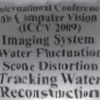Free Online Productivity Tools
i2Speak
i2Symbol
i2OCR
iTex2Img
iWeb2Print
iWeb2Shot
i2Type
iPdf2Split
iPdf2Merge
i2Bopomofo
i2Arabic
i2Style
i2Image
i2PDF
iLatex2Rtf
Sci2ools
CVPR
2010
IEEE
2010
IEEE
A Globally Optimal Data-Driven Approach for Image Distortion Estimation
Image alignment in the presence of non-rigid distortions is a challenging task. Typically, this involves estimating the parameters of a dense deformation field that warps a distorted image back to its undistorted template. Generative approaches based on parameter optimization such as Lucas-Kanade can get trapped within local minima. On the other hand, discriminative approaches like Nearest-Neighbor require a large number of training samples that grows exponentially with the desired accuracy. In this work, we develop a novel data-driven iterative algorithm that combines the best of both generative and discriminative approaches. For this, we introduce the notion of a “pull-back” operation that enables us to predict the parameters of the test image using training samples that are not in its neighborhood (not
| Added | 12 Apr 2010 |
| Updated | 14 May 2010 |
| Type | Conference |
| Year | 2010 |
| Where | CVPR |
| Authors | Yuandong Tian, Srinivasa Narasimhan |
Comments (0)

